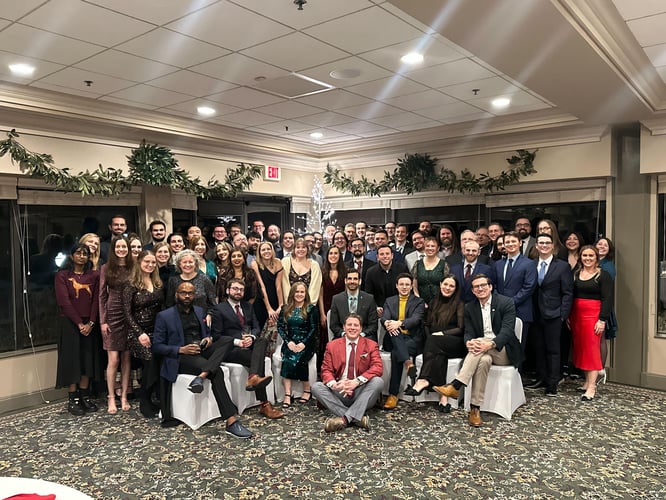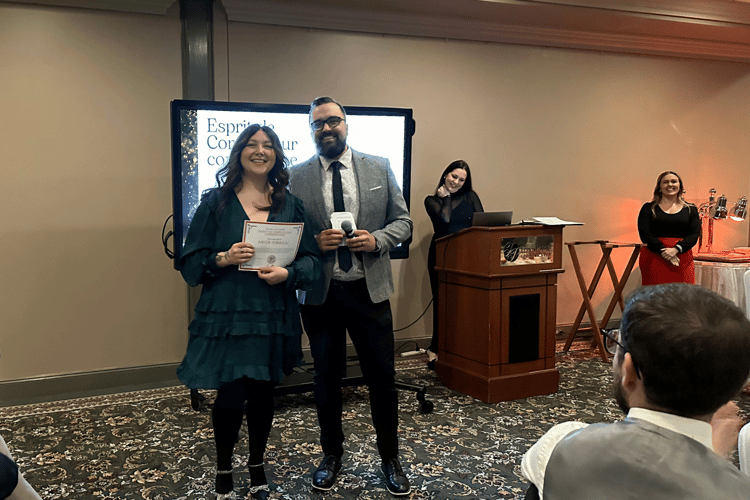Tech jobs can be hectic, and stress from the pandemic and non-stop work from home demands have 70% of tech workers reporting exhaustion. Tech workers also rank just after healthcare workers in terms of burnout this year, because many tech jobs require professionals to be on call 24/7.
Mindfulness can help.
Mindfulness practice isn’t just meditation on a cushion. It’s a lifestyle that can be integrated even during a busy work day, and can improve relaxation, focus, health, and job satisfaction. There are many health benefits of mindfulness and benefits to a productive workplace.
Mindfulness can help you reduce chronic pain, depression, stomach problems, and it can also help you absorb more information and come up with more creative ideas. More than ever before, companies and employees are recognizing the value of a healthy workplace to keep everyone at their happiest and most productive.
Most of all, mindfulness makes you feel rested and energized. If you’ve been looking for a healthy way to maintain your peace of mind and presence during the work day, here are some tips from pros who know mindfulness in all its most helpful forms for busy professionals.
Checking in with your body for a healthy work day
Greg Knollmeyer of Spiral Chi Center teaches tai chi, a type of mindful martial art you might see practiced in parks by large groups. Tai chi is considered a moving meditation. Knollmeyer also works with musicians and other professionals to correct their posture and be mindful of how they use their bodies through the day to avoid repetitive strain injuries. Checking in with your body before the work day even begins is a simple way to practice mindfulness. You can correct a tense posture before it turns into a chronic injury, or just remember to breathe and focus your energy where you want to for the day ahead. Here are some exercises Knollmeyer recommends for busy professionals to avoid stress turning into injury or illness.
“Beditating” Practice
Consider this: We are stressed because our current situation makes it hard to relax. So attempting to relax during a stressful day is like trying to learn how to fight the moment after you’ve been punched. It is better to learn before. Likewise we must learn how to relax when we are not stressed and then recall that relaxed state later in stressful circumstances.
I highly recommend a practice I playfully call “beditating.” When you wake up, spend 5 minutes in bed exploring how far your breath reflects in your body. Do you feel your belly rise and fall? Can you relax more and even feel it change in your pelvis and down your legs? Don’t get out of bed until you feel like you are breathing with your whole body. You will feel much more together as you start your day. Later at work when you are stressed, rest your hands on your desk. Relax the back of your neck and your shoulders. Remember how it felt to breathe with your whole body when you were beditating. Just breathe for a few moments and bring yourself closer to that state. If you can close your eyes, that is even better.
A number of clients that come to me for healing have really benefited from this practice. Myself and my students develop more full practices in taiji, qigong, and meditation. But I still beditate each morning.
Body and mind release
We humans have the great benefit of being conscious of ourselves and time. But that also makes it hard for us to let go. We so easily continue to think about the past and worry about the future even when we have already taken appropriate actions. Not only does this holding on in the mind take up processing space in our minds, it creates a holding on--tensions — in the body. This tension slows everything down: We don’t breathe as deeply and get less oxygen. It slows our circulation. This is like driving with the parking brake engaged. Myriads of benefits come from letting go. There is literally no dis-ease that does not have stress as a significant cause. It is almost always time to let go.
Mindful exercises you can do at your desk
Tech workers are often tasked with rapid decision making during the day, and that can result in a lot of muscle tension and stress. Rachel Egherman of Celebrated Heart teaches a mindfulness process called Heart Math, which is a way to check in with your body’s wisdom through the heart space to keep your whole self in alignment to feel relaxed and supported. She has some quick tips for checking in with your body and staying mindful during the workday that don’t require a long period of time.
Smile break
Take a smile break. Smiling has been shown to release endorphins in the body the counteract the negative effects of stress. I recommend to first feel the smile in your eyes by allowing the corners of your eyes to gently move up and then with your lips very gently pressed together let your lips move into a smile. The brilliance of this is that you can literally do it anywhere.
Stay hydrated
Make sure that you are well hydrated. It doesn’t take long for the body to become dehydrated. Our brain is 80% water and when we are dehydrated it can lead to brain fog, inability to focus, headaches, irritability, and poor memory. Coffee, sodas, sugary drinks, and tea can contribute to dehydration. Room temperature or warm filtered or purified water, with a squeeze of fresh lemon or lime really is the best.
Bouncing exercise
Bouncing for a minute is probably my favorite way to release stress. Stand with your legs hip width apart and your arms hanging at your side. Make sure that your knees are not locked but are slightly bent. Keep your heels on the floor and let the bounce come from your knees. Relax every part of your body as you bounce. Try this for a minute. It works.
Mindfulness exercises for a workday break
Julie Woodward of Mindful Awakenings teaches mindfulness through yoga, coaching, and forest hikes. She has been a therapist, a health educator, and is a founding member of the Ann Arbor Center for Mindfulness. She also has a graduate degree in molecular biology with a concentration in psychobiology. As such, she knows a thing or two about how stress affects the body. Woodward says that mindfulness exercises can be integrated into your daily routine. She recommends the following simple exercises to start.
“These practices can be done any time, in any location, whenever you need a break. Even a 3-5 minute practice can help you unwind tension and teach your nervous system to relax more quickly over time.”
Woodward recommends experimenting with when and how you do mindful awareness practice to see what works best for you. You can set an alert on your phone, or notice the signs of stress in your body and choose a mindfulness practice for self-care when you need a boost.
Pause Practice
When you notice your stress level building, let that become a signal for you to choose to pause. Take a deep breath in, feel your chest and abdomen expand, and exhale slowly, releasing tension. Draw a second breath in, feel sensations in your body as you expand, and as if the breath comes all the way down to your lower back and hips. Feel sensation in your shoulders, back, and chest as you exhale slowly. Repeat, anchoring your awareness of feeling the sensations in your body as you breathe in, and breathe out. When you feel ready, resume your activities at work. Notice your experience and how this greater sense of awareness and relaxation comes into your day.
Mindful Movement Practice
If you notice that your mind or emotions are really active and sitting still doesn’t appeal to you, you might choose to do a mindful movement practice. The key with this practice is to shift your awareness from the busy thinking/doing/fixing mode into being mode and to choose to direct your attention to feel your body sensation from the inside as you move. A simple practice might be standing up at your desk, and scanning your body with your attention, feeling the soles of your feet as you stand, your ankles, legs, hips, pelvis, torso, spine and head. You might like to begin stretching your arms over head, breathing in as you lift your arms, exhaling as you lower your arms. Notice what stretch or movement your body needs, and begin that. If the mind takes off on a train of thought, allow that, and bring your attention back to feel your body as you move. You might like to roll your shoulders forward and back, bend from side to side, shift your weight from one foot to the other as you feel the sensation in the muscles you move. Breathe deeply, inhaling and exhaling as you move. If you have the space, you could take a mindful walk, feeling the sensation in the soles of your feet as you walk. As you finish your movement practice, feel the space within your body. What do you notice? Repeat as often as you like!
Find a purpose-driven job
We hope these tips help you relax during your busy day. Another way to improve your health at work is to find a job you love that feels purpose-driven, with a healthy working environment. If you’re looking for a new tech job, consider looking for a job with wellness benefits, or with a culture that supports employees in feeling their best as well as doing their best.





.png?width=50&name=Erin%20Gregory%20(1).png)

